Fire Emblem Fates is a soap opera strategy game. You’ll spend as much time agonising over battlefield tactics as you will wondering which characters should, like, totally hook up.
Like 2013’s Fire Emblem: Awakening, Fates is a tactical role-playing game that allows players to control an army of fantasy chess pieces. Each piece has its own rules for movement and combat, and more importantly, each piece is its own individual character with his or her own specific hopes and dreams. The more you fight alongside your troops, the better you’ll get to know them outside of the battlefield. Fire Emblem is as much about relationships as it is about war.
While the long-running Fire Emblem series has let players foster relationships with troops for a while now, Awakening intensified things by letting characters have kids with each other. It was a decision that split the fanbase between those who loved the military manoeuvring but feared the series was turning into “anime garbage“, and those who were delighted to have an unusual brand of dating sim to play.
The game’s makers at Intelligent Systems must have noticed that divide, because the latest Fire Emblem is split into two versions: Birthright and Conquest. Each game has unique aspirations that cater to the tastes of the two camps, and depending on which one you choose to play, you’ll get an entirely different set of characters to meet, war scenarios to conquer and narrative threads to explore.
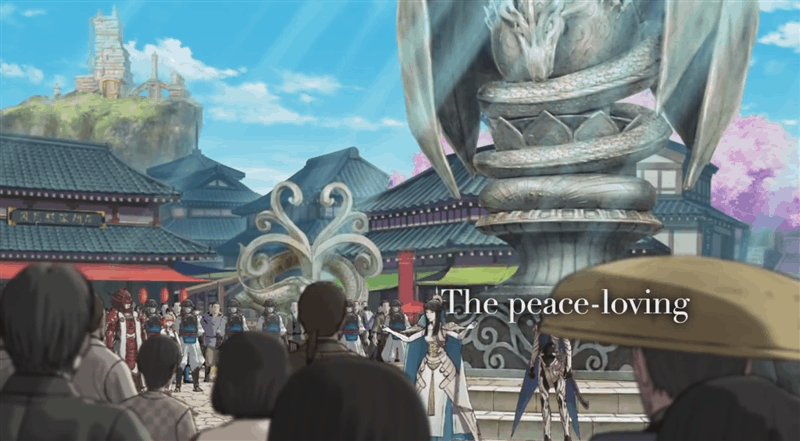
Regardless of which version of the game you choose, you play as Corrin, a young noble caught between two warring nations, Hoshido and Nohr. A few chapters in, Corrin is faced with a choice (if you only bought one version of the game, it’s not actually a choice, but if you own both, you really do make a decision). Do you side with the faction that Corrin grew up with, the Nohr of Conquest? Or do you choose Corrin’s actual blood relatives, the Hoshido of Birthright? (DLC gives players a third option in the form of a campaign titled Fire Emblem Fates: Revelation, which is supposed to give players more insight into the events of Birthright and Conquest.)
Truthfully, the game doesn’t spend enough time getting to know either party to warrant such a dramatic early choice. I based my decision on more superficial factors, like which version had the hotter characters. (Conquest. The right answer is Conquest.)
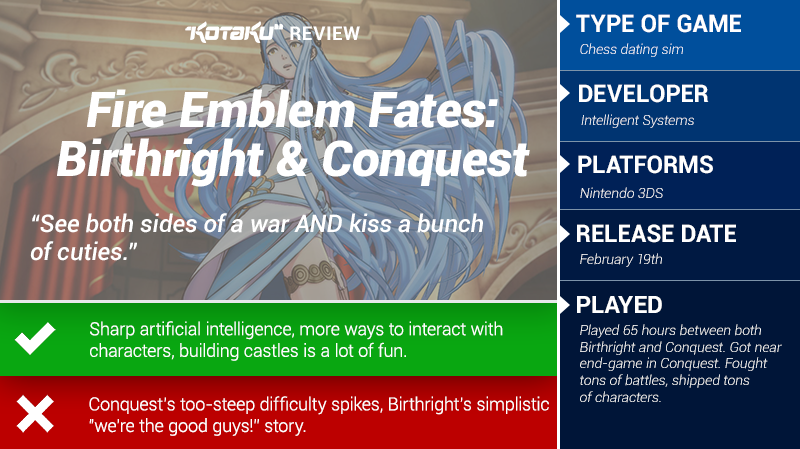
Given how rushed the introduction is, I was surprised to find just how much my initial choice ended up haunting me, especially given how hammy Fates‘s writing often is. Your decision makes the other side your mortal enemy, which means that over the course of the story, you’ll have to tear down brothers and sisters alike. I recommend playing through both versions, if only so that you can know the full torment of watching siblings beg you to stop a murderous rampage, or the torture of having to kill someone who was your best friend the first time around.
The Hoshido of Birthright are the obvious moral “good” choice here. The Nohr are the arsehole villains who take great pleasure in needless bloodshed, whereas the Hoshido just want to live in peace, maaaan. I mean, it’s slightly more complicated than that — as you play through Conquest, you learn that some people on that side aren’t so bad after all, but overall, aligning with Nohr puts you in a moral grey area at best. That’s exactly what makes it so interesting to play Conquest, assuming you can live with the guilt of being evil just to see what happens.
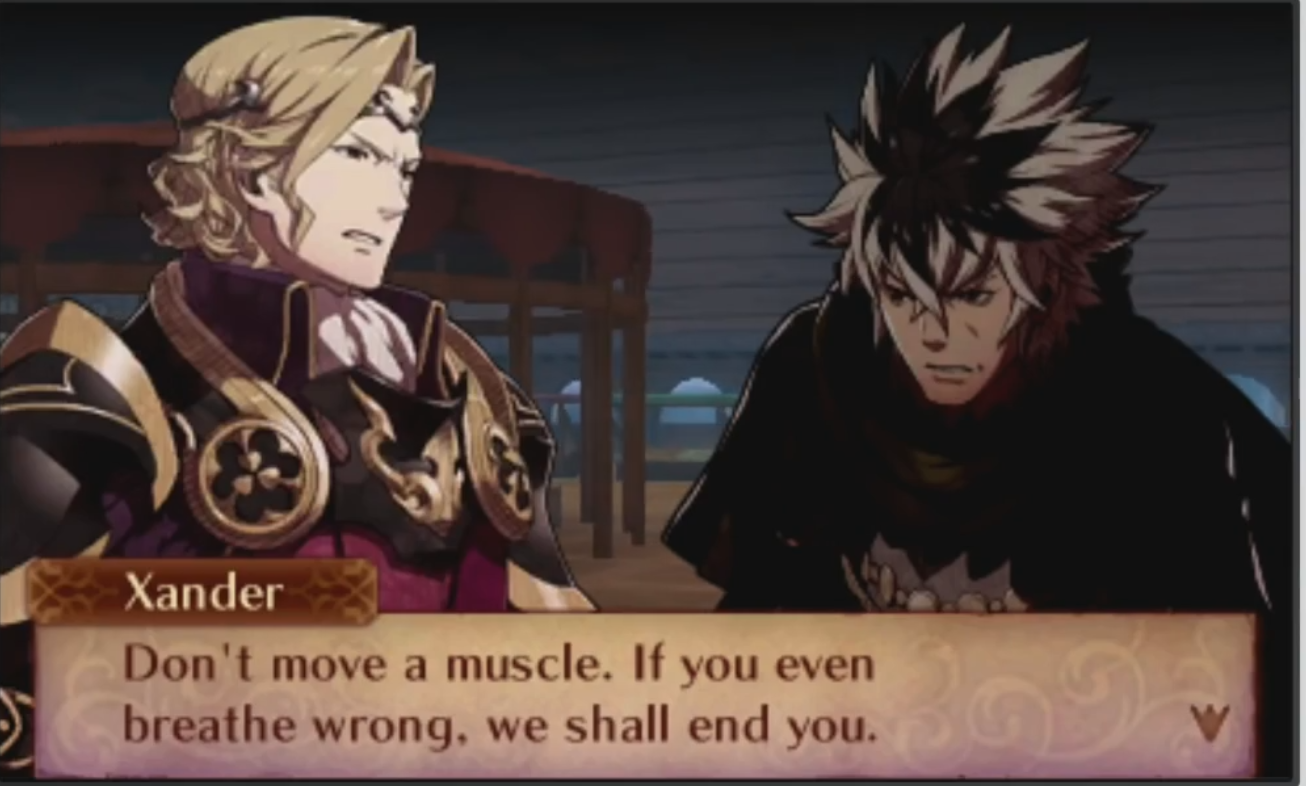
As if to punish you for choosing the villains of Conquest, that side of the game is ridiculously difficult. Narratively, this is explained by the fact that the King of Nohr is trying to make your life miserable; he doesn’t trust you after you met your birth family, even though you’ve allied yourself with him. Even on the earliest levels of Conquest, and on the lowest difficulty setting, I found myself constantly overwhelmed by a sharp and ruthless AI. Beating a single stage might take me dozens of tries spread out over multiple days.
Conquest doesn’t just have tougher enemies than Birthright, most missions also include a cruel twist or added challenge. In one chapter, you might find yourself wading through an ice village where walkways can freeze or melt, restricting your movement. In another, you might be trapped in an arena up against an endless stream of fighters who just won’t stop spawning, no matter how many you kill.
At my lowest, I’d curse Conquest for being so unfair — just how many times could the AI nail a 1 per cent critical against me, anyway? But damn, when I prevailed, that adrenaline high was something else. I never enjoyed the feeling for long: the next level would always be worse. As I chopped away at the campaign, I couldn’t help but wonder what, exactly, Intelligent Systems thinks of its more hardcore fanbase. The entire thing is framed as a joyless punishment for the protagonist, after all.
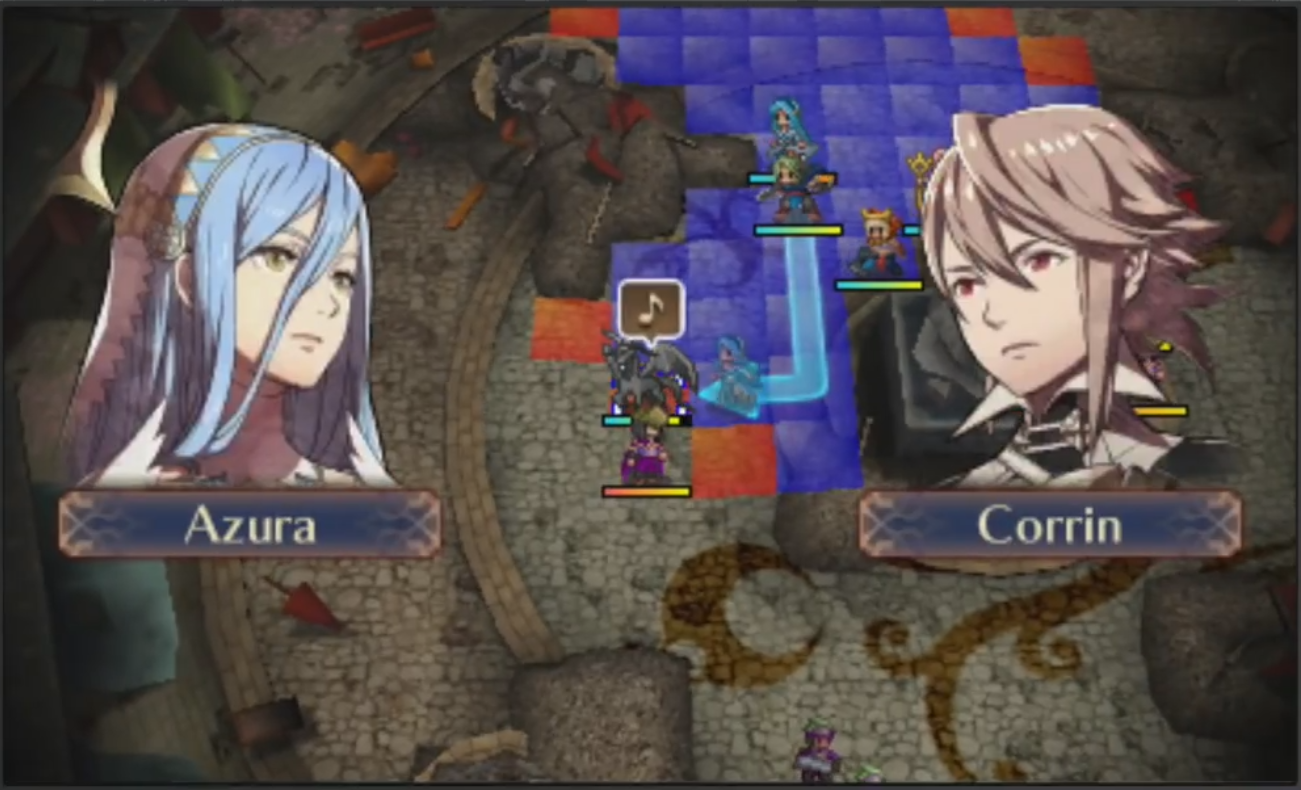
Birthright is a more straightforward game, where you always have the confidence that you’re Doing The Right Thing (boring!). Aimed at more casual fans, Birthright’s samurai combat is less about intense battlefield strategy and more about getting your characters to smooch each other. While I enjoy the brain-bending challenge of classic Fire Emblem, I also adore the romantic aspect of the newer games. When done right, this more frivolous side of the game fleshes out each and every soldier in the field. The result is a war fought by actual people, which is crucial in making me give a damn about Fire Emblem’s signature permanent death mode — where each and every fatality is final.
While I can certainly pick out a few favourites from the larger roster, I found that this time around, Fire Emblem’s characters were less memorable than those in Awakening. I was disappointed by how many boring if not outright annoying conversations I had in Fates, and I never quite got used to how many of my relationships had incestuous overtones. I still looked forward to talking to everyone, but I didn’t always go in with the confidence I’d enjoy the exchange.
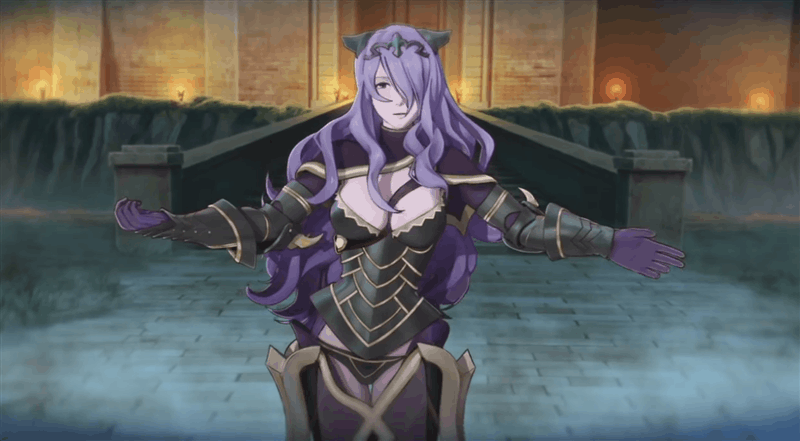
Fates actually doubles down on the series’ more erotic elements. Both versions of the game give you something called “Personal Quarters”, where the only things you can do are either A) Change your hair and B) “Invite allies”. Calling someone over then gives you a close-up of that character’s 3D model. Everyone always blushes at this point, or says something sweet to you, the player (sometimes more, if you’re married). The Japanese version infamously let players rub other characters without their consent during this portion of the game, but that’s (mostly) gone from the Western version.
You can feel the empty space left in its absence, too — the scenes are perplexingly brief. In fact, taking the petting out just makes these encounters paradoxically more suggestive. Sometimes, you’ll call someone over while your character lounges on his or her bed, Titanic-style. I’m not sure what the game’s developers want me to think happens during these “INVITE ALLIES” sessions, but when left to my imagination, I’m going to assume the blushing isn’t because my character is playing pattycake with the soldiers under her command.
Have I mentioned that you can also visit a bathhouse, where occasionally you’ll get embarrassing scenes where you walk in on the opposite sex? Or that you can order your soldiers to parade around with nothing but a towel? I love all of that stuff, but I am also the sort of trashcan fan who loves spending way too much time shipping characters.
Ostensibly, Fire Emblem Fates‘ full two-version incarnation caters to every type of fan. After playing through a good chunk of both Conquest and Birthright, it feels like most of the improvements and additions were made for so-called ‘casual’ aficionados. The core gameplay of Fire Emblem hasn’t really changed much: you still move units around in a grid, these units can still level up as they go along and transform into mightier soldiers that you know and love. Tweaks to that formula are small. Weapons no longer degrade and break down, for example. And there are a few new classes to try out, such the ever-swift Ninja, a class that can throw shuriken from a distance, and Butlers, a loyal class that can use daggers and staves. Mostly, the new classes feel like slight alterations of already existing ones from prior games, which isn’t very exciting.
Otherwise, the most noticeable additions aren’t found on the battlefield, but rather in your options for spending downtime, when Corrin isn’t crossing swords with anyone. Fire Emblem Fates comes with a new “My Castle” mode, and as the name suggests, players can customise and build a fort full of amenities. Every station is manned by your recruits, which means you have even more opportunities to interact with your favourite characters.
If a mage is behind the cashier at the rod shop, they will probably give you a discount on spells. If a general finds himself in the kitchen, he might surprise you with his cooking skills. Sometimes, characters might just hang out randomly on castle grounds, and you can go up to them and chat. Occasionally, these conversations will even reward you with items or stat bonuses. I love the small new ways Fates‘ castle let me interact with my warriors. It feels like a more personal game because of it.
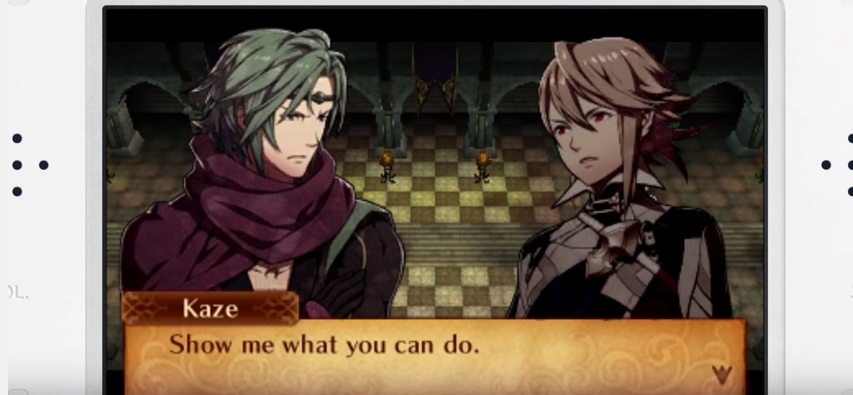
There’s more of a social aspect to My Castle, as well. Taking a page from Animal Crossing, Fire Emblem lets players visit their 3DS friends’ citadels. Every castle grows unique ore and food items, so there’s even a gameplay reason to go online and meet other people. Those resources can then be traded for accessories, or cooked for stat boosts. Not only is it fun to see how people decorate their castles, visiting other people also lets you duel them, asynchronously taking on computer-controlled versions of their best roster. The more you play against others, the more the game rewards you with gifts, too.
Since 2013, the Fire Emblem series has felt torn between its longstanding reputation for top-down strategy and its newfound popularity as a game of high-stakes romance. With Fates, the series hasn’t frayed under the pressure. Instead, Intelligent Systems has created one of the most narratively ambitious games to hit a Nintendo platform. Fire Emblem Fates lets you explore the value of familial love and friendship, then offers you the option to go back and kill everyone you love, while loving everyone you killed.
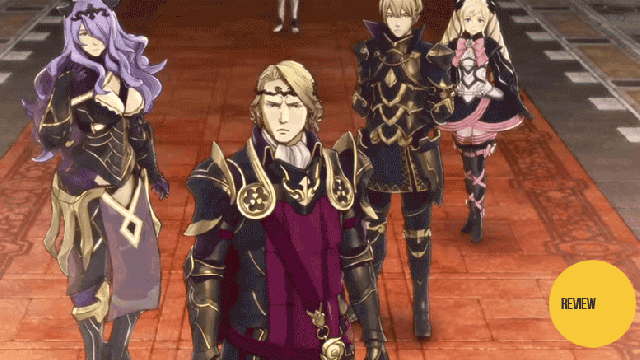
Comments
14 responses to “Fire Emblem Fates: Birthright And Conquest: The Kotaku Review”
BRING ON FIRE EMBLEM.
I think this is a re-post of US Kotaku’s review when it released in their region? Not complaining!
Also, refreshing to read about the game without the odious ‘translation’ faux-outrage.
It’d be like if religious fundamentalists were able to ingratiate themselves into every conversation about Harry Potter and turn anything remotely to do with Hogwarts into something about children learning about the occult.
My only outrage is real: petting is love. Petting is life.
(still getting the game though)
Again, what if the EU regions get a version with that stuff in it? Or altered in some other way?
Can you imagine the river of shit that would stem from such a thing?
I’d have a good chuckle 🙂
It’s funny though, because Miku’s Project Diva f and F 2nd are all about the petting (and the whole rhythm game thing, I guess) and they are released in EU/NA no problem. I put it down to Japanese companies having sometimes strange views about how western sensibilities work.
So how does the custom made translation hold up?
Ding ding ding.
The game may have received similar treatment to other games and been localised by a completely different body of people for the European release (multiple languages other than English are stored on the cart but the English stuff is also specialised, for a second or third time some times).
We won’t know that until we get our hands on the game.
I hope they keep the internet memes.
I’m hoping this is the case, purely because we’ve had to wait for so long!
Well, it mostly always is.
If the other languages and or a tailored English localiSation were a priority during the actual development of the game, we’d see that development period stretch out much longer.
Despite what the internet thinks, Nintendo have a pretty fair idea about how to effectively manage the development costs associated with bringing a video game to release.
Simultaneous worldwide releases are great, but look at indie games. They almost never release in multiple languages to begin with. It’s American English or buzt.
I really don’t get the weird ‘controversy’ this game has generated. You can’t rub a girl like she’s a damn dog and one questionable scene was slightly altered.
Story is the game. Gameplay is the same. 99.98% of the game is the same as the Japanese version. The experience will be just as good. Yet… massive stink kick up. So bizzare.
People get passionate about the weirdest things…
I on the other hand am super excited to to get my collectors ed this weekend ^_^
Haven’t really touched my DS since sinking 130hours into MH4U.
But the problem is, Nintendo is acting like a parent that is overprotecting their childen. Censoring stuff because they think it will be insulting to the west but making it sounds like it is for the greater good.
It is that attitude that pissed people off, not the actual content that was cut off.
Regardless I’ll be getting my collectors this weekend as well, I don’t care about what they do 😛
My thoughts line up well with @wisp. It’s a business decision. Morally I think it’s a bit dishonest that company applies different standards in different regions but from a business standpoint, its perfectly understandable and encouragable. Adjusting some details for new audiences to maximize the potential customer base is a pretty smart thing to do. And this (the petting thing) wasn’t even anything major, it was just a very strange minigame that formed an insignificant portion of gameplay, that I assume a particular type of people get a boner over? Not sure. I won’t drag this out, but I’ll remind you Homer Simpson is crazy about soda not beer n the middle-east 😛
I’m reasonably glad for the changes. I accept that the potion controversy was pretty silly, especially having read the full context of it. Wasn’t even a gay cure.
Personally though, glad they got rid of that weird petting thing. Particularly the forced petting. It’d be a weird thing to explain to my wife and/or people on the bus. But they kept the ‘petting’ type interaction with your significant other which is actually a nice touch. Game is richer for the changes I feel. And definitely not anything worth boycotting over. I’m glad to hear you’ll be getting the game same as me 😉
Naw. It’s not about babying you. Nintendo’s like only recently become profitable again and it’s sales in the west especially America are still only just managing to get good. The wiiu is still a huge money drain and basically they have to be sensitive because they don’t need any bad media. Especially when they are trying to launch a new console in the near future which people already doubt thanks to the wiiu. I honestly think what they cut was not worth keeping anyway. I mean look at bayonetta 2. They were shocked by the freedom Nintendo gave them. Plenty of boobs in emblem too. I think It’s fair to draw the line at borderline sexual harassment and Forced sexuality changes though.